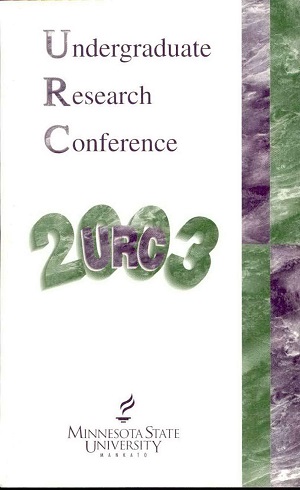Generation of Most-Probable-Number (MPN) Estimates of Indigenous Freshwater Bacteria Capable of Degrading Hydrocarbons
Location
CSU
Student's Major
Computer Information Science
Student's College
Science, Engineering and Technology
Mentor's Name
Elaine O. Hardwick
Mentor's Department
Biological Sciences
Mentor's College
Science, Engineering and Technology
Description
Many industrial and municipal wastes such as motor oil and phenol contain hydrocarbons that enter lakes and streams. Some aquatic bacteria exposed to these wastes can degrade the pollutants. The purpose of this project is to estimate the abundance of freshwater bacteria that degrade phenol and/ or motor oil as a source of nutrients for growth. Sediment samples, taken from Ox Bow Lake (Mankato, MN), will be amended with motor oil and phenol and then incubated for eight weeks. Samples will be removed to estimate bacterial abundance. In addition, an MPN technique will select for freshwater bacteria that can degrade these two types of hydrocarbons. Estimates of the abundance of hydrocarbondegrading bacteria will be accomplished by three different procedures: (i) a published MPN procedure, which uses Microsoft Excel program Solver; (ii) viable plate counts and (iii) total counts.
Generation of Most-Probable-Number (MPN) Estimates of Indigenous Freshwater Bacteria Capable of Degrading Hydrocarbons
CSU
Many industrial and municipal wastes such as motor oil and phenol contain hydrocarbons that enter lakes and streams. Some aquatic bacteria exposed to these wastes can degrade the pollutants. The purpose of this project is to estimate the abundance of freshwater bacteria that degrade phenol and/ or motor oil as a source of nutrients for growth. Sediment samples, taken from Ox Bow Lake (Mankato, MN), will be amended with motor oil and phenol and then incubated for eight weeks. Samples will be removed to estimate bacterial abundance. In addition, an MPN technique will select for freshwater bacteria that can degrade these two types of hydrocarbons. Estimates of the abundance of hydrocarbondegrading bacteria will be accomplished by three different procedures: (i) a published MPN procedure, which uses Microsoft Excel program Solver; (ii) viable plate counts and (iii) total counts.




